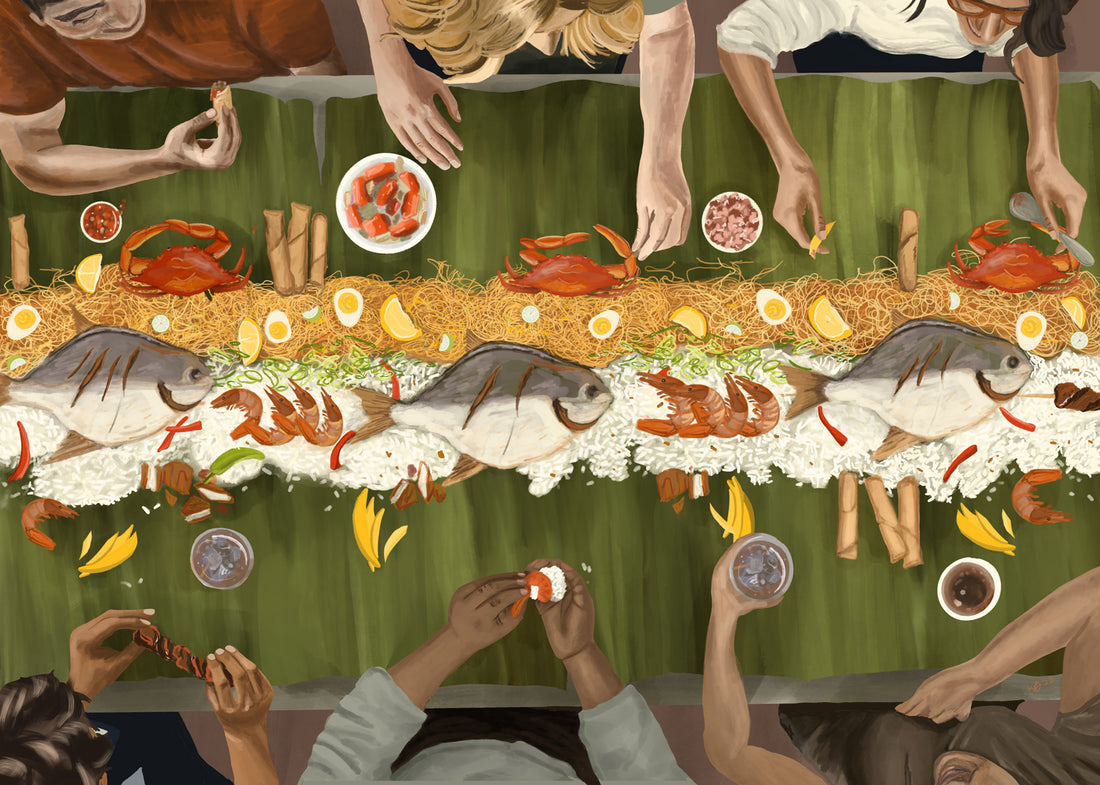Artwork by Kristina Brown Art, Website www.kristinabrownart.com.
Food is more than sustenance; it’s a cultural experience that connects us to our heritage and brings people together. In the Philippines, one of the most cherished and unique culinary traditions is Kamayan, also known as a "boodle fight." This dining style, where utensils are set aside and food is enjoyed using bare hands, is more than just a meal; it’s a celebration of community, heritage, and Filipino values.
The Background of Kamayan
The word "Kamayan" comes from the Tagalog word “kamay,” which means "hand." This practice of eating with hands dates back to pre-colonial times in the Philippines when the natives used banana leaves as plates and hands to eat their meals. The Spaniards, who colonized the Philippines for over 300 years, introduced utensils to the local populace. However, the traditional way of eating with one’s hands persisted and is still widely practiced today, especially during informal gatherings and celebrations.
The tradition of Kamayan evolved to also be associated with the boodle fight, a term coined by the Philippine military. It describes a communal meal where food is laid out on long tables lined with banana leaves, and everyone digs in using their hands. The boodle fight signifies camaraderie, equality, and unity among the participants, breaking down social barriers as everyone partakes in the same meal.
The Kamayan Experience
A Kamayan feast is as much about the presentation as it is about the food. A typical spread includes an array of dishes, often featuring grilled meats, seafood, fresh fruits, vegetables, and rice—the staple food of the Philippines. Everything is beautifully arranged on banana leaves, enhancing the sensory experience with the fragrance of the leaves mingling with the aroma of the food.
Participants gather around the table, often in an outdoor setting or around a low table where they can comfortably eat sitting down. There are no plates or utensils—only hands. Before starting, a brief moment is usually taken to wash hands and give thanks for the meal. Then, everyone digs in, sharing food and stories, creating a communal atmosphere that is warm, inclusive, and celebratory.

Cultural Significance of Kamayan
Kamayan is more than just a method of eating; it’s a cultural statement that reflects Filipino values of hospitality, family, and community. It represents the essence of bayanihan, a Filipino term that refers to the spirit of communal unity and cooperation. Eating together in this manner fosters a sense of closeness and equality, as there is no hierarchy at the table—everyone shares the same food in the same way.
Moreover, Kamayan embodies the Filipino philosophy of "living in the moment." There’s an informality and relaxed nature to Kamayan that encourages participants to enjoy the food, savor each bite, and engage in conversation. It strips away the pretenses of formal dining and focuses on the joy of eating and the pleasure of good company.
Kamayan in a Global Context
Interestingly, Kamayan is not unique to the Philippines. Many cultures around the world have traditions of eating with hands. In India, eating with hands is a customary practice deeply rooted in Ayurvedic principles, where touch is considered one of the five senses and an integral part of the eating experience. In Ethiopia, injera, a sourdough flatbread, is used as a utensil to scoop up flavorful stews and salads. Similarly, in the Middle East, bread often serves as a tool to scoop and eat various dishes.
However, the Filipino Kamayan stands out due to its emphasis on communal eating and the joy of sharing food with others. It is less about the formalities of eating and more about the connections made at the table. This cultural practice has found its way into global cities with significant Filipino populations, like Los Angeles, New York, and Toronto, where restaurants offer Kamayan-style dining experiences to both Filipinos longing for a taste of home and curious food enthusiasts looking to try something new.
Embracing Kamayan Today
Kamayan is seeing a resurgence, particularly among the younger generation of Filipinos and Filipino-Americans who are eager to reconnect with their roots and share their heritage with others. Social media has also played a role in popularizing Kamayan, as photos of colorful, bountiful spreads of food on banana leaves captivate audiences worldwide, sparking curiosity and interest.
Whether it’s a large family gathering, a community event, or a modern restaurant experience, Kamayan continues to evolve while staying true to its roots. It’s a reminder of the power of food to bring people together, to break down barriers, and to celebrate what it means to be Filipino.
Conclusion
Kamayan is more than just a way of eating; it’s a celebration of life, culture, and togetherness. It’s a testament to the enduring Filipino spirit of community, hospitality, and joy. As more people around the world experience Kamayan, they not only discover the rich flavors of Filipino cuisine but also the warmth and generosity that define Filipino culture. So next time you come across a Kamayan feast, don’t be afraid to roll up your sleeves, wash your hands, and dig in—you’re not just enjoying a meal; you’re becoming part of a beautiful tradition.

